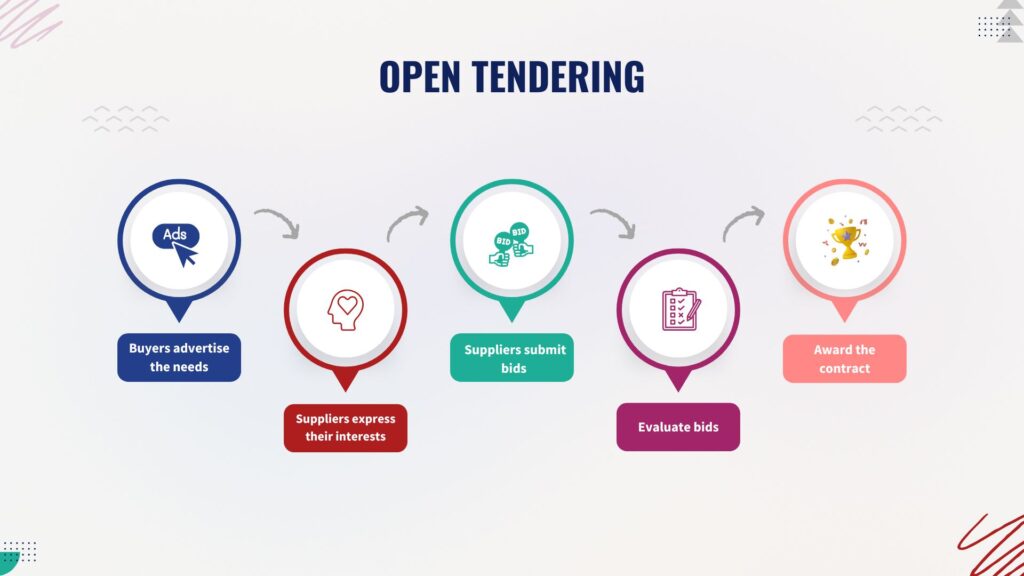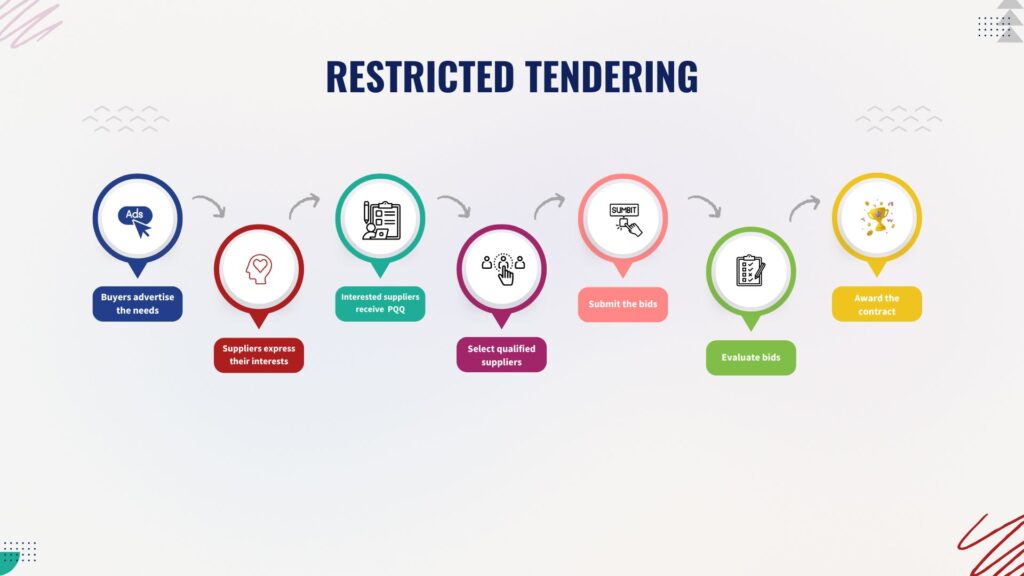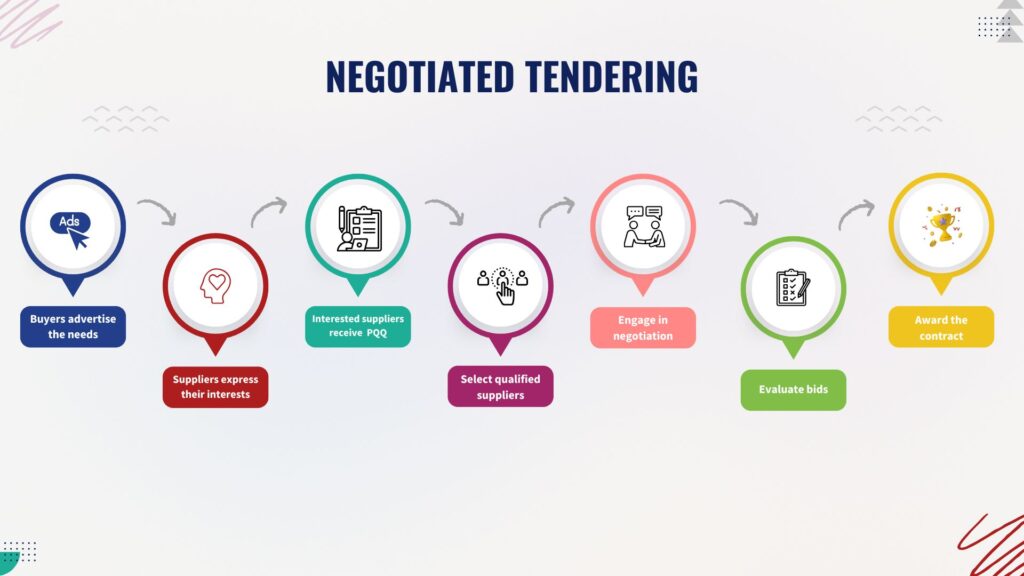Key Approaches to The Tendering Process
Types of tendering are featured in the CIPS study guides, and are frequently asked about in the exams. As a buyer, you must understand the basic principles of tendering, enabling you to apply this knowledge properly in the workplace. There are many types of tendering, but in the context of this article, I would like to introduce three common ones: open tendering, restricted tendering and negotiated tendering.
Open tendering:
This type of tendering refers to a sourcing process in which any supplier is able to submit a bid based on the establised business needs and specifications.

According to the graph 1, the open tendering follows 5 key steps:
- Buyers advertise their needs: They need to prepare at least the specifications, delivery timelines, and other requirements, then advertise this information through various channels such as official government portals, local or national newspapers, industry publications or trade journal, the buyer’s websites or an e-tendering system. This activity aims to attract suppliers’ interests.
- Suppliers express their interests: Many suppliers can view the advertisement, and some express their interests in the business’ needs.
- Suppliers submit bids: After expressing interests, suppliers are allowed to submit their bids.
- Evaluate bids: In open tendering, the buying organization mainly focus on price and quality criteria. Buyers evaluate supplier’s bids based on the established criteria, ensuring fairness and transparency.
- Award the contract: After evaluating the bids, buyers select an outstanding supplier who is capable of delivering the contract.
When to use open tendering:
- The buying organization clearly understand about its business needs, enabling it to generate precise conformance specification.
- The requirements are not complex. This means that the features, sizes or structures of required items are standardized in the market. Most suppliers offer items which have almost the same specifications. Hence, they compete primarily on price or customer services.
- The purchased items are not critical. In open tendering, suppliers are not pre-qualified before submitting their bids. If a winning bidder fails to deliver the contract, the buying organization suffers minimal damage.
Restricted tendering

Unlike open tendering, suppliers go through 2 rounds of evaluation before being selected to deliver the contract. After advertising the business’s needs, interested suppliers start experiencing the first appraisal round. They receive a pre-qualification questionaire (PQQ), in which the buying organization provides a list of questions to evaluate suppliers. Through the PQQ, buyers can narrow down the list of interest suppliers to those who are qualified and eligible to participate in the tendering process.
Suppliers who successfully pass the first evaluation round receive the invitation to tender and submit bids. The inviation to tender normally involves an overview of business needs, product specification, tender instruction, evaluation criteria, contractual terms, and submission forms. After receiving supplier’s bids winthin a given time frame, buyers proceed to evaluate those bids accroding to pre-determined criteria to select the winning bidder. Clearly, the restricted tendering process may take longer than open tendering. The question is when to use the restricted tendering.
- The required products/ services are critical to the business. Any delay in supply or decline in quality will cause significant damage to the buying organization.
- The buying organization expects a high interest in their business needs from bidders. A two-stage process will be used to “filter” prospective suppliers and select the one who offers the highest value for money.
- The buying organization clearly understands its business needs, allowing it to generate a precise conformance or performance specification for suppliers.
Negotiated tendering

Negotiated tendering generally follows the same innitial process as restricted tendering. In this type of tendering, the buying organization has not clearly identified its business needs, as they are specilized and tailor-made. The organization lacks the specilized knowledge required to generate detailed specification of its needs. Moreover, there are no available suppliers in the market who can fulfill the business needs. In this case, early supplier involvement is necessary to finalize the solution for the business’s need (the contract’s scope), pricing and other terms. This activity is illustrated in stage 5 of the negotiated process in Figure 3. Normally, only one supplier or very few suppliers can engage in the negotiated tendering process because:
- They possess specialized skills and knowledge
- They are the sole supplier in the market capable of fulfilling the business needs
- They are chosen due to pre-existing close relationship with the buying organization
When to use negotiated tendering:
- The business requirement is highly complex, and the buying organization is unable to define it clearly.
- There is only one supplier capable of fulfilling the business needs.
We provide CIPS practice questions with answers and detailed explanation, besides they are updated regularly to reflect the actual exam. If you want to consolidate your knowledge before the exam, you can check the links below. The discount code is SUNNYDAY25.
L4M1: https://www.udemy.com/course/cips-l4m1-practice-test-short-learning-guide/?couponCode=SUNNYDAY25
L4M2: https://www.udemy.com/course/cips-diploma-l4m2-practice-test/?couponCode=SUNNYDAY25
L4M3: https://www.udemy.com/course/cips-diploma-practice-test-commercial-contracting/?couponCode=SUNNYDAY25
L4M4: https://www.udemy.com/course/cips-diploma-practice-test-ethical-responsible-sourcing/?couponCode=SUNNYDAY25
L4M5: https://www.udemy.com/course/cips-practice-test-commercial-negotiation/?couponCode=SUNNYDAY25
L4M6: https://www.udemy.com/course/cips-diploma-practice-test-supplier-relationships/?couponCode=SUNNYDAY25
L4M7: https://www.udemy.com/course/level-4-diploma-whole-life-asset-management-l4m7/?couponCode=SUNNYDAY25
L4M8: https://www.udemy.com/course/cips-l4m8-practice-in-procurement-and-supply/?couponCode=SUNNYDAY25
L5M1: https://www.udemy.com/course/updated-l5m1-full-course-managing-teams-and-individuals/?couponCode=SUNNYDAY25
L5M2: https://www.udemy.com/course/cips-l5m2-daniel-do/?couponCode=SUNNYDAY25
L5M3: https://www.udemy.com/course/l5m3-daniel/?couponCode=SUNNYDAY25
L5M4: https://www.udemy.com/course/l5m4-advanced-contract-and-finance/?couponCode=SUNNYDAY25
L5M5: https://www.udemy.com/course/l5m5-daniel/?couponCode=SUNNYDAYG25
L5M15: https://www.udemy.com/course/updated-cips-l5m15-practice-questions-advanced-negotiation/?couponCode=SUNNYDAY25